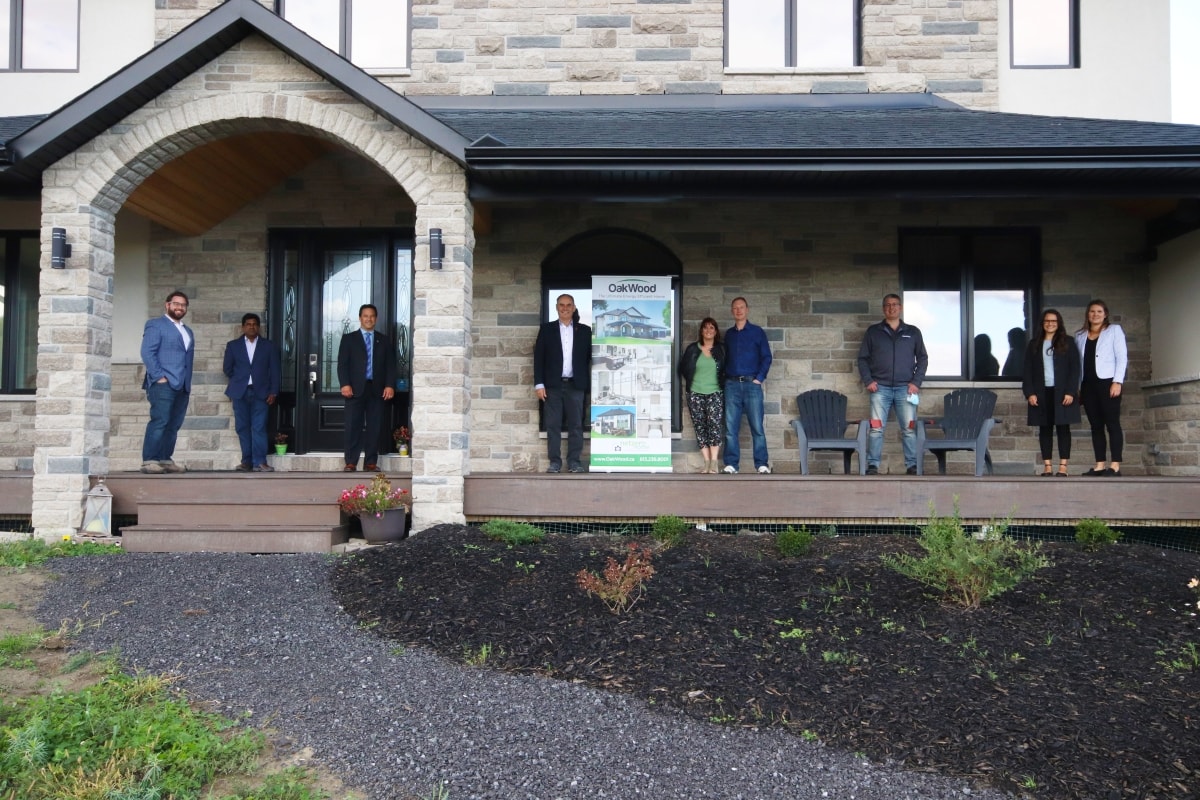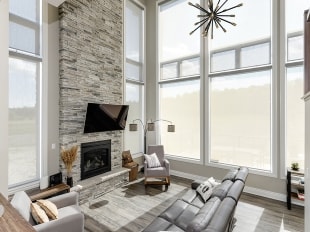OakWood Celebrates Becoming a Qualified Net Zero Home Builder


OakWood recently met another important milestone by becoming a Qualified Net Zero home builder through the Canadian Home Builders’ Association (CHBA). The achievement was celebrated by CHBA on October 1, 2020 with an onsite announcement and media release. The ceremonial event took place on-site at OakWood’s first Net Zero Ready custom home, designed and built to meet CHBA’s stringent qualification.
What is a Net Zero Home?
According to the CHBA, a Net Zero home produces as much clean energy as it consumes, usually through the use of solar panels. As a result, its EnerGuide rating – a measure of energy consumption in gigajoules per year – is zero.
Net Zero pay back
In addition to enjoying an energy efficient home, Net Zero homeowners can join Hydro One’s Net Metering program or similar program from their local utility. This allows them to send electricity generated from a renewable energy source to Hydro One’s distribution system for a credit towards their electricity costs. Any additional, unused electricity earns them credits that can be carried forward for a consecutive 12-month period.










Net Zero Ready
“Net Zero ready” means the home meets all Net Zero requirements in terms of building envelope measures, high-efficiency equipment, and load reduction measures – such as LED lighting and low flow fixtures to reduce water consumption. It has the potential to generate as much energy as it uses but does not yet have the renewable energy producing capability installed. Basically, it’s waiting for the installation of solar panels or wind power or both.
As well, the home has been reviewed to ensure it can house the necessary solar regeneration required to offset all energy usage. Roof measures are taken to make sure there is enough room for solar panels and how many panels that will go on each side. The orientation of the panels to the sun affects how much the panel can produce during the year.
This was the case for the energy efficient home that OakWood designed and built to qualify as a Net Zero home builder. Our client expects to hook-up solar panels and move from Net Zero Ready to fully Net Zero in the near future
Requirements for Net Zero certification
The home is tested through specialized software that considers many factors. An energy advisor makes recommendations for improvements to improve the home’s performance and these can vary from house-to-house depending on the design and home’s orientation and surroundings. Factors such as air tightness, increased levels of insulation, HVAC efficiency, high-efficiency Energy Star appliances, triple glazed windows, and water saving systems are some of the considerations that go into designing and building a certified Net Zero home.
Home orientation and surrounding features are also a big factor. Exposure to the sun has implications for heating and cooling. This was the case with our client’s home which was southeast facing with a bank of large windows. Those beautiful windows provided very bright space that got a lot of sun leading to solar gain. In the winter, that’s terrific because it lowers the energy demand for heating. During the summer however, it puts pressure on the A/C system. To offset that, we needed to up the insulation wall values, increase air tightness, and use blinds with our triple pane windows to lower energy costs.
Third party verification is required during the design and construction process to inspect and verify insulation levels, windows, and mechanical systems. A final pressurized air tightness test (blower door test) is also conducted to confirm that air leakage meets minimum requirements (less than 1.5 air changes per hour).
Our client’s home passed with flying colours. But what does that mean in terms of practical benefits to them?
Top benefits of a Net Zero home
Huge savings on energy – For a Net Zero (vs. Net Zero Ready) Home there are no energy costs. That means you are saving money in your own pocket rather than paying Hydro One. It also means you’re protected from future energy costs, which could be a big deal over the coming years.
Year round comfort – Advanced construction coupled with superior heating, cooling, and ventilation means even temperatures and a pleasant home environment to live in year round.
Cleaner, fresher indoor air quality – Airtight walls coupled with built-in filtered fresh air systems reduce pollutants such as pollen and dust that trigger allergies and asthma. Fresh air is introduced into the home using a controlled system that gives the homeowner clean air to breathe but in a way that does not affect comfort like a leaky window or door would. The result is a healthier living space.
Perfect for peace and quiet – A Net Zero home is tightly built and well insulated. Outside noises from traffic, lawn cutting, snow removal, and barking dogs, are virtually silenced.
A more durable home with higher resale value – the use of advanced materials, building techniques and technologies that are used to build a Net Zero home results in a more durable home with lower maintenance costs. As a result, homeowners can expect a higher resale value.
Finally, the advanced materials, building techniques and technologies that are used to build a Net Zero home results deliver a more home and lower maintenance costs. As a result, homeowner can expect a higher resale value.
Return on Investment
Is it worth making the additional investment to design and build a certified Net Zero home? For many, the qualitative benefits summarized above are enough to offset any increases in material and building costs. There is a value to your regular enjoyment of being in your home…especially these days!
OakWood also generates a report using energy savings and lower cost of home ownership to show clients how long it would take to payback additional costs for building to Net Zero standards. It’s not an exact measure, because the real costs from energy usage are based on how people use their homes;and everyone uses their home differently. We also install an energy monitor as part of the certification so homeowners can track and adjust to reduce their energy consumption.
Whether to build to Net Zero or not will soon become a moot point. By 2030, the National Building Code of Canada is expected to make Net Zero the building standard. So, in the near feature, all new homes in Canada will be sustainable and energy efficient. Building to Net Zero now enables you to be ahead of the curve and at the forefront of sustainability and health.
Talk to an expert
If you’re thinking of designing and building a custom home, it’s definitely worth considering a consultation with our Project Consultants. This will allow you to delve into the numerous advantages that come with Net Zero homes. Additionally, you can make the most of OakWood’s recently acquired expertise as an accredited Net Zero Home Builder!





